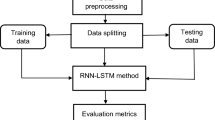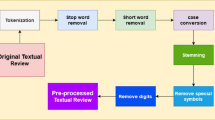Abstract
The social media revolution has provided the online community an opportunity and facility to communicate their views, opinions and intentions about events, policies, services and products. The intent identification aims at detecting intents from user reviews, i.e., whether a given user review contains intention or not. The intent identification, also called intent mining, assists business organizations in identifying user’s purchase intentions. The prior works have focused on using only the CNN model to perform the feature extraction without retaining the sequence correlation. Moreover, many recent studies have applied classical feature representation techniques followed by a machine learning classifier. We examine the intention review identification problem using a deep learning model with an emphasis on maintaining the sequence correlation and also to retain information for a long time span. The proposed method consists of the convolutional neural network along with long short-term memory for efficient detection of intention in a given review, i.e., whether the review is an intent vs non-intent. The experimental results depict that the performance of the proposed system is better with respect to the baseline techniques with an accuracy of 92% for Dataset1 and 94% for Dataset2. Moreover, statistical analysis also depicts the effectiveness of the proposed method with respect to the comparing methods.

















Similar content being viewed by others
References
Ahmad S, Asghar MZ, Alotaibi FM, Awan I (2019) Detection and classification of social media-based extremist affiliations using sentiment analysis techniques. Hum-centric Comput Inform Sci 9(1):24
All things Anaconda (2019) https://anaconda.org/anaconda/notebook. Accessed 26 Nov 2018
All things Convolution (2019) https://en.wikipedia.org/wiki/Convolution. Accessed 15 Dec 2018
All things embeddings (2019) Embedding Retrieved from https://keras.io/layers/embeddings/. Accessed 05 Jan 2019
All things preprocessing (2019) Text preprocessing https://keras.io/preprocessing/text/. Accessed 9 Jan 2019
All things Sequential (2019) The sequential model API https://keras.io/models/sequential/. Accessed 10 Dec 2018
All things transform. (2018) Transforming categorical data https://developers.google.com/machine-learning/data-prep/transform/transform-categorical. Accessed 31 Nov 2018
Asghar MZ, Ullah A, Ahmad S, Khan A (2020) Opinion spam detection framework using hybrid classification scheme. Soft Comput 24(5):3475–3498
Bhatia R (2017) Understanding the difference between deep learning & machine learning https://analyticsindiamag.com/understanding-difference-deep-learning-machine-learning/. Accessed 13 Dec 2018
Bornstein A (2018) Beyond word embeddings part 2 https://towardsdatascience.com/beyond-word-embeddings-part-2-word-vectors-nlp-modeling-from-bow-to-bert-4ebd4711d0ec. Accessed 23 Nov 2018
Brownlee J (2017a) A gentle introduction to transfer learning for deep learning https://machinelearningmastery.com/transfer-learning-for-deep-learning./Accessed 26 Nov 2018
Brownlee J (2017b) What are word embeddings for text? https://machinelearningmastery.com/what-are-word-embeddings/. Accessed 10 Jan 2019
Chen Z (2013) http://www.cs.uic.edu/~zchen/. Accessed 4 Jan 2019
Chen Z, Liu B, Hsu M, Castellanos M, Ghosh R (2013). Identifying intention posts in discussion forums. In HLT-NAACL, pp 1041–1050
Colah (2015) Understanding LSTM Networks http://colah.github.io/posts/2015-08-Understanding-LSTMs/. Accessed 29 Nov 2018
Cui C, Mao W, Zheng X, Zeng D (2017). Mining user intents in online interactions: applying to discussions about medical event on SinaWeibo platform. In: International conference on smart health, Springer, Cham, pp 177–183
Ding X, Liu T, Duan J, Nie JY (2015) Mining user consumption intention from social media using domain adaptive convolutional neural network. In: Twenty-Ninth AAAI conference on artificial intelligence
Ding X, Cai B, Liu T, Shi Q (2018). Domain adaptation via tree kernel based maximum mean discrepancy for user consumption intention identification. In: IJCAI, pp 4026–4032
Goldberg AB, Fillmore N, Andrzejewski D, Xu Z, Gibson B, Zhu X (2009). May all your wishes come true: a study of wishes and how to recognize them. In: Proceedings of human language technologies: the 2009 annual conference of the North American chapter of the association for computational linguistics, association for computational Linguistics, pp 263–271
Goldhammer M, Köhler S, Zernetsch S, Doll K, Sick B, Dietmayer K (2019) Intentions of vulnerable road users–detection and forecasting by means of machine learning. IEEE Trans Intell Transp Syst 21(7):3035–3045
Gupta V, Varshney D, Jhamtani H, Kedia D, Karwa S (2014). Identifying purchase intent from social posts. In: ICWSM
Habib A, Akbar S, Asghar MZ, Khattak AM, Ali R, Batool U (2018a). Rumor detection in business reviews using supervised machine learning. In: 2018 5th international conference on behavioral, economic, and socio-cultural computing (BESC), IEEE, pp 233–237
Habib A, Saddozai FK, Sattar A, Khan A, Hameed IA, Kundi FM (2018b). User intention mining in business reviews: a review. In: 2018 5th international conference on behavioral, economic, and socio-cultural computing (BESC), IEEE, pp 243–249
Hamroun M, Gouider MS, Said LB (2015). Customer intentions analysis of twitter based on semantic patterns. In: The 11th international conference on semantics, knowledge and grids, pp 2–6
Hollerit B, Kröll M, Strohmaier M (2013). Towards linking buyers and sellers: detecting commercial intent on twitter. In: Proceedings of the 22nd international conference on world wide web, ACM, pp 629–632
Kao LJ, Huang YP (2017) Predicting purchase intention according to fan page users' sentiment. In: 2017 IEEE international conference on systems, man, and cybernetics (SMC). IEEE, pp 831–835
Khan F, Borah S, Pradhan A (2016) Mining consumption intent from social data: a survey
Khodabandelou G, Hug C, Deneckere R, Salinesi C (2013) Supervised intentional process models discovery using hidden Markov models. In: IEEE seventh international conference on research challenges in information science (RCIS)
Lee LH, Lin BL, Yu LC (2018) Tseng YH Chinese grammatical error detection using a CNN-LSTM model
Li C, Du Y, Wang S (2017) Mining implicit intention using attention-based RNN encoder-decoder model. In: International conference on intelligent computing, Springer, Cham, pp 413–424
Li S, Zhang L, Diao X (2019) Deep-learning-based human intention prediction using RGB images and optical flow. J Intell Robot Syst 97:1–13
Liu R, Li Y, Qi J (2009). Making customer intention tactics with network value and churn rate. In: Wireless communications, networking and mobile computing, 2009. In: WiCom’09. 5th international conference, IEEE, pp 1–4
Luong TL, Tran TH, Truong QT, Phi TT, Phan XH (2016) Learning to filter user explicit intents in online Vietnamese social media texts. In: Asian conference on intelligent information and database systems, Springer, Berlin, Heidelberg pp 13–24
Luong TL, Truong QT, Dang HT, Phan XH (2016). Domain identification for intention posts on online social media. In: Proceedings of the seventh symposium on information and communication technology, ACM, pp 52–57
Luong TL, Cao MS, Le DT, Phan XH (2017) Intent extraction from social media texts using sequential segmentation and deep learning models
Lyu Y, Huang X (2018). Road segmentation using CNN with GRU. arXiv preprint arXiv:1804.05164
Marcelino P (2018) Transfer learning from pre-trained models https://towardsdatascience.com/transfer-learning-from-pre-trained-models-f2393f124751. Accessed 12 Dec 2018
Moujahid A (2016) A practical introduction to deep learning with caffe and python. http://adilmoujahid.com/posts/2016/06/introduction-deep-learning-python-caffe/. Accessed 12 Jan 2019
Park DH, Fang Y, Liu M, Zhai C (2016). Mobile app retrieval for social media users via inference of implicit intent in social media text. In: Proceedings of the 25th ACM international on conference on information and knowledge management, ACM pp 959–968
Pedregosa F, Varoquaux G, Gramfort A, Michel V, Thirion B, Grisel O, Blondel M, Prettenhofer P, Weiss R, Dubourg V, Vanderplas J, Passos A, Cournapeau D, Brucher M, Perrot M, Duchesnay E (2011) Scikit-learn: machine learning in python. JMLR 12:2825–2830
Pérez-Vera S, Alfaro R, Allende-Cid H (2017) Intent classification of social media texts with machine learning for customer service improvement. In: International conference on social computing and social media, Springer, Cham, pp 258–274
Ramanand J, Bhavsar K, Pedanekar N (2010) Wishful thinking: finding suggestions and 'buy' wishes from product reviews. In: Proceedings of the NAACL HLT 2010 workshop on computational approaches to analysis and generation of emotion in text, association for computational linguistics, pp 54–61
Rhanoui M, Mikram M, Yousfi S, Barzali S (2019) A CNN-BiLSTM model for document-level sentiment analysis. Mach Learn Knowl Extr 1(3):832–847
Rudkowsky E, Haselmayer M, Wastian M, Jenny M, Emrich Š, Sedlmair M (2018) More than bags of words: sentiment analysis with word embeddings. Commun Methods Meas 12(2–3):140–157
Shah T (2017) Train, validation and test sets. https://tarangshah.com/blog/2017-12-03/train-validation-and-test-sets/. Accessed 8 Nov 2018
Sharma A (2018) Differences between machine learning & deep learning. https://www.datacamp.com/community/tutorials/machine-deep-learning. Accessed 18 Dec 2018
Ujjwalkarn (2016) An intuitive explanation of convolutional neural networks https://ujjwalkarn.me/2016/08/11/intuitive-explanation-convnets/. Accessed 15 Dec 2018
Vo QH, Nguyen HT, Le B, Nguyen ML (2017) Multi-channel LSTM-CNN model for Vietnamese sentiment analysis. In: 2017 9th international conference on knowledge and systems engineering (KSE), IEEE, pp 24–29
Wang J, Cong G, Zhao WX, Li X (2015) Mining user intents in twitter: a semi-supervised approach to inferring intent categories for tweets. In: AAAI, pp 318–324
Wang X, Jiang W, Luo Z (2016) Combination of convolutional and recurrent neural network for sentiment analysis of short texts. In: Proceedings of COLING 2016, the 26th international conference on computational linguistics: technical papers, pp 2428–2437
Wang Y, Huang J, He T, Tu X (2019) Dialogue intent classification with character-CNN-BGRU networks. Multimedia Tools Appl 79:1–20
Phuong TM, Linh LC, Bach NX (2019) Identifying intentions in forum posts with cross-domain data. J Heuristics. https://doi.org/10.1007/s10732-019-09410-3
Zhang T, Cho JH, Zhai C (2014). Understanding user intents in online health forums. In: Proceedings of the 5th ACM conference on bioinformatics, computational biology, and health informatics, ACM, pp 220–229
Zhang C, Fan W, Du N and Yu PS (2016) Mining user intentions from medical queries: a neural network based heterogeneous jointly modeling approach. In: Proceedings of the 25th international conference on World Wide Web, international world wide web conferences steering committee, pp 1373–1384
Zhang Y, Yuan H, Wang J, Zhang X (2017) YNU-HPCC at EmoInt-2017: Using a CNN-LSTM Model for sentiment intensity prediction. In: Proceedings of the 8th workshop on computational approaches to subjectivity, sentiment and social media analysis, pp 200–204
Zhang D, Tian L, Hong M, Han F, Ren Y, Chen Y (2018) Combining convolution neural network and bidirectional gated recurrent unit for sentence semantic classification. IEEE Access 6:73750–73759
Zhao J, Liu K, Xu L (2016) Sentiment analysis: mining opinions, sentiments, and emotions. Bing Liu (University of Illinois at Chicago) Cambridge University Press, 2015, 381 pp. ISBN 9781107017894. https://doi.org/10.1162/COLI_r_00259
Zhou C, Sun C, Liu Z, Lau F (2015) A C-LSTM neural network for text classification. arXiv preprint arXiv:1511.08630
Acknowledgement
This Research work was supported by Zayed University Research Incentives Fund#R18052.
Author information
Authors and Affiliations
Corresponding author
Ethics declarations
Conflict of interest
All authors declare that they have no conflict of interest
Ethical approval
This article does not contain any studies with human participants performed by any of the authors and does not contain any studies with animals performed by any of the authors.
Additional information
Communicated by V. Loia.
Publisher's Note
Springer Nature remains neutral with regard to jurisdictional claims in published maps and institutional affiliations.
Electronic supplementary material
Below is the link to the electronic supplementary material.
Rights and permissions
About this article
Cite this article
Khattak, A., Habib, A., Asghar, M.Z. et al. Applying deep neural networks for user intention identification. Soft Comput 25, 2191–2220 (2021). https://doi.org/10.1007/s00500-020-05290-z
Published:
Issue Date:
DOI: https://doi.org/10.1007/s00500-020-05290-z




